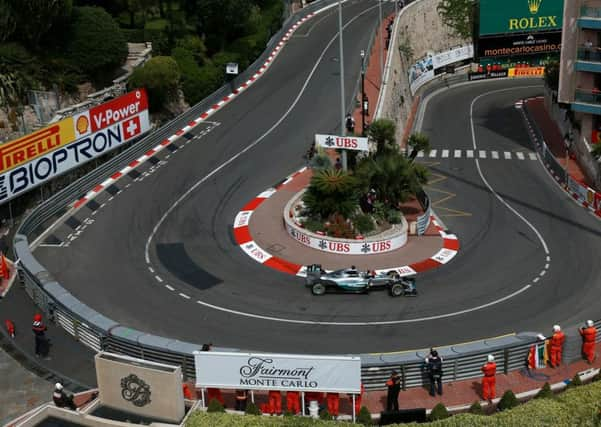Talking Motors: Magical Monaco


There are dates on the calendar that are ringed off before it goes up on the wall in January and this Sunday is one of them.
Granted, it can be argued appreciating the Monaco Grand Prix requires the viewer to look out for the finer points. But then again, the same can be argued for other dates the diary demands are cleared for watching sport.
Advertisement
Hide AdAdvertisement
Hide AdRarely does an FA Cup Final, a Challenge Cup Final or heavyweight boxing fight offer sustained excitement for the duration of the contest.
That’s the nature of sport when so much is at stake, although punctuated by moments of brilliance the excitement grows from nerves rather than class. Given such events aren’t just favourites, but adored by fans suggests that they are enhanced, rather than hampered, by their cagey nature.
Monaco is in the same stable of events. Okay, so the championship points on offer to teams and drivers are the same as they are at say, the Spanish Grand Prix, but Monaco’s prestige and history, not to mention the unique demands it places on those involved, amplify its importance. Ever since 1929 motorsport has been in love with Monaco. It was part of the pre-Second World War European Championship and was a fixture in the first Formula One World Championship series in 1950.
That first race 87 years ago was won by the wonderfully-named William Grover-Williams, though being the first hero of one of the most famous races in the world didn’t afford him the status you might expect.
Advertisement
Hide AdAdvertisement
Hide AdHe won an absolute fortune from the race, 100,000 Francs, which was £11,000. He went on to become an agent for the Special Operations Executive in the Second World War, but was arrested by the intelligence agency of the Nazi Party and executed at the Sachsenhausen concentration camp in 1945.
Britain’s most successful Monaco hero was Graham Hill, who won the race five times in the ‘60s, earning him the title Mr Monaco. Hill is also the only person to have completed the Triple Crown of Motorsport: Monaco, the Le Mans 24 hours and Indianapolis 500.
And the sport’s King of Monaco is, of course, Ayrton Senna, with six wins there to his name.
The track is narrow, has tight turns, drastically changing elevation and a slower average speed than any other Grand Prix.
Advertisement
Hide AdAdvertisement
Hide AdAnd at 161.7 miles it’s also the only race in the current F1 calendar that doesn’t adhere to the minimum race distance requirement of 190 miles.
But even as the shortest race, it is one of the most demanding, with drivers changing gear 62 times per lap (around 5,000 per race) and having to hold off blinking for the seven seconds per lap spent at full throttle. That is through the tunnel which is immediately followed by a tight hairpin on the harbour.
Despite having never been, I know the layout of the Monaco track inside out and back to front.
When I was young enough for it still be acceptable to play on games consoles, I spent an obscene amount of time on various F1 games whizzing around the principality, pixelated front wings hanging off thanks to getting too personal with barriers and then going off to read about races from years gone.
Advertisement
Hide AdAdvertisement
Hide AdThe closest I’ve ever come to the drive in real life is pretending the tunnel on the A50 next to Stoke’s Britannia Stadium is the one at Monaco.
And the chances of ever getting to see the race in the flesh are slim for me.
Hotels are often booked up a full year in advance and even then you’re looking at tens of thousands of Euros for the race weekend.
As a poor substitution, you’ll find me in Stoke.
It would appear if you live in London and don’t own a Range Rover, the chances are you have a Nissan Figaro.
Advertisement
Hide AdAdvertisement
Hide AdExamples of the diminutive Japanese automatic, designed to cash in on the classic car boom of the 1990s, are around every corner in residential streets, maybe as back-up seeing as I saw a street closed off last time I was there because a Chelsea Tractor had caught fire.
Introduced at the Tokyo Motor Show in 1989, 20,000 Figaros were eventually built, and (another) visit down south recently revealed they all appear to have ended up in the capital. Available only as a three-speed automatic, 8,000 were originally available, solely marketed in Japan.
But their throwback looks and ease to drive in city traffic made them so popular there was an additional production run of 12,000 with prospective buyers having to enter a lottery to win the chance to buy one.
And for their year of production, they were all made in 1991, they offered some futuristic touches, with air conditioning and CD a player.
Advertisement
Hide AdAdvertisement
Hide AdThey were available in four colours to represent the four seasons. Topaz Mist for autumn - a kind of brown usually first seen by new parents.
Emerald Green for spring - think the last time you showered at a student flat.
Pale Aqua for summer - the sky on a photo of Blackpool beach.
Lapis Grey for winter - look at the canal on a really cold day.
Advertisement
Hide AdAdvertisement
Hide AdYou’d think this trendiness, coupled with the fact plenty of examples are for sale around the £4,000 mark would result in them being parked-up outside trendy cafes but you’d be wrong.
This trendiness seems to have made them the ideal accessory for a £2,000-a-week flat on the commuter belt.
But you know what? Classic status is in the eye of the beholder - and if this trend keeps these oddly likeable disguised Micras on the road, then that can’t be a bad thing.